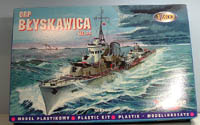 ORP
Blyskawica was one of two British designed and built destroyer leaders delivered
to Poland in the years immediately prior to the second world war. Designed
and built by the firm of J Samuel White, Blyskawica (Lightning) and identical
twin Grom (Thunder), were heavily armed, large, fast and designed for Baltic
service. Both vessels were fortunate enough to be ordered to the UK at the
outbreak of war. While Grom was sunk in 1940 off Norway, Blyskawica survived
the war, to be returned to Poland and, ultimately, preserved as a museum ship
in the port of Gdansk. Blyskawica is a unique survivor of pre-war British
destroyer design and construction, and is a worthy memorial to the role played
by Polish sailors in the Second World War.
ORP
Blyskawica was one of two British designed and built destroyer leaders delivered
to Poland in the years immediately prior to the second world war. Designed
and built by the firm of J Samuel White, Blyskawica (Lightning) and identical
twin Grom (Thunder), were heavily armed, large, fast and designed for Baltic
service. Both vessels were fortunate enough to be ordered to the UK at the
outbreak of war. While Grom was sunk in 1940 off Norway, Blyskawica survived
the war, to be returned to Poland and, ultimately, preserved as a museum ship
in the port of Gdansk. Blyskawica is a unique survivor of pre-war British
destroyer design and construction, and is a worthy memorial to the role played
by Polish sailors in the Second World War.
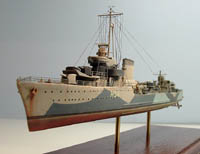 In
1941 Blyskawica's original main armament and heavy mast were replaced, as
the ship was apparently overloaded for open ocean service. Blyskawica emerged
from refit with a main armament of four twin Mk. XIX four inch mounts and
a lighter tripod mast. Later refits saw the close range armament of the ship
improved and additional radar, making Blyskawica one of the most formidably
and adequately armed destroyers to serve in European and Mediterranean waters.
It also served to make the ship even more like its Royal Navy contemporaries
in appearance.
In
1941 Blyskawica's original main armament and heavy mast were replaced, as
the ship was apparently overloaded for open ocean service. Blyskawica emerged
from refit with a main armament of four twin Mk. XIX four inch mounts and
a lighter tripod mast. Later refits saw the close range armament of the ship
improved and additional radar, making Blyskawica one of the most formidably
and adequately armed destroyers to serve in European and Mediterranean waters.
It also served to make the ship even more like its Royal Navy contemporaries
in appearance. 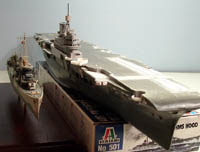
Mirage make a number of kits of both Blyskawica and  Grom,
depicting them in pre and early war fit, and showing Blyskawica in late war
(43-44) and post war ('67) guises. I bought and built the 43-44 version of
Blyskawica, as I was keen to practice disruptive camouflage painting and weathering
techniques, prior to completing my build of HMS Victorious (also shown in
some of the images as a size comparison).
Grom,
depicting them in pre and early war fit, and showing Blyskawica in late war
(43-44) and post war ('67) guises. I bought and built the 43-44 version of
Blyskawica, as I was keen to practice disruptive camouflage painting and weathering
techniques, prior to completing my build of HMS Victorious (also shown in
some of the images as a size comparison).
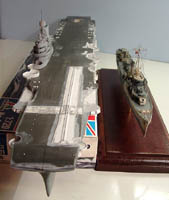 The
kit is fairly straightforward and of reasonable quality both in moulding and
detail. The only real problems in construction were some gaps in fitting the
main deck aft to the hull, some sink marks in the sides of stowage boxes and
some evidence of mould damage/deterioration which shows as slight depressions
and streaks in the hull sides. It is clearly an earlier effort than Mirage's
kit of the French built Burza and Wicher, as this latter kit is much better
and more crisply detailed.
The
kit is fairly straightforward and of reasonable quality both in moulding and
detail. The only real problems in construction were some gaps in fitting the
main deck aft to the hull, some sink marks in the sides of stowage boxes and
some evidence of mould damage/deterioration which shows as slight depressions
and streaks in the hull sides. It is clearly an earlier effort than Mirage's
kit of the French built Burza and Wicher, as this latter kit is much better
and more crisply detailed.
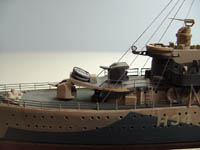 Additions
to the kit included some correction of minor detail, replacement of the masts
with brass rod and tube, opening up of the solidly moulded funnel cowl and
addition of a stretched sprue grille, replacement of kit supplied 20mm guns
with etched equivalents, new 40mm barrels added to the kit base (the barrels
started life as 5.5 inch guns on the Italeri Hood) and some additional detail
to the 4 inch mounts - canvas mantlets, sighting ports and the characteristic
rear overhang. There is no specific etched set available for these kits (a
pity, as Mirage make one for their smaller Torpedo boat kits and U-Boats)
so I made do with odds and sods. Railing, ladders and gunnery radar are from
a Tom's Modelworks set intended for KGV, the etched Oerlikons are actually
1/350 from WEM, the parbuckle stowage and stern depth charge rails started
life as girder detail for 1/500 scale Japanese aircraft carriers. Anchor chain
and the very nice anchors came from the GMM 1/700 'anchor and chain' set.
These little etched anchors look great when completed, and the size range
is sufficient to do any kind of destroyer in 1/400 scale. Watertight doors
are from the GMM 1/400 set.
Additions
to the kit included some correction of minor detail, replacement of the masts
with brass rod and tube, opening up of the solidly moulded funnel cowl and
addition of a stretched sprue grille, replacement of kit supplied 20mm guns
with etched equivalents, new 40mm barrels added to the kit base (the barrels
started life as 5.5 inch guns on the Italeri Hood) and some additional detail
to the 4 inch mounts - canvas mantlets, sighting ports and the characteristic
rear overhang. There is no specific etched set available for these kits (a
pity, as Mirage make one for their smaller Torpedo boat kits and U-Boats)
so I made do with odds and sods. Railing, ladders and gunnery radar are from
a Tom's Modelworks set intended for KGV, the etched Oerlikons are actually
1/350 from WEM, the parbuckle stowage and stern depth charge rails started
life as girder detail for 1/500 scale Japanese aircraft carriers. Anchor chain
and the very nice anchors came from the GMM 1/700 'anchor and chain' set.
These little etched anchors look great when completed, and the size range
is sufficient to do any kind of destroyer in 1/400 scale. Watertight doors
are from the GMM 1/400 set.
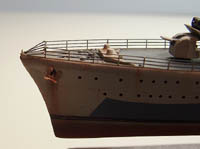 The
real fun in this kit was painting. Tape was used to mark out the 'in' strakes
of hull plating before the undercoat was applied. Once removed, the hull had
acquired the characteristic horizontal strakes of a riveted hull.
The
real fun in this kit was painting. Tape was used to mark out the 'in' strakes
of hull plating before the undercoat was applied. Once removed, the hull had
acquired the characteristic horizontal strakes of a riveted hull.
I make no guarantees about the actual colours used to depict the Admiralty
disruptive pattern scheme. The kit instructions call out Humbrol colours which
have no real equivalents. A short discussion with John Snyder of WEM fame
came up with some possible Colourcoat RN equivalents for the period in question,
but in the end the choice was mine, so please don't beat up on John for my
mistakes. 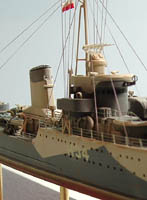
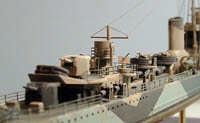 Painting
- and weathering - started with the faded black used for the boot topping.
After this I mixed three colours to depict the typical weathering and marine
growth at and around the waterline. I christened these 'Admiralty bleached
weed', which was a white mixed with a tiny amount of green, 'Admiralty Slime
Green', which was a stronger mixture of green with white, and 'Dark Admiralty
Slime Green', which was a straight Humbrol 149. These were sprayed, from the
boot topping down, in the thinnest overlapping bands that I could manage,
followed by WEM RN antifouling red. Don't spray red first, unless you want
pink weed. Once this was all dry the masking on the boot topping was moved
half way up (to where the ship would, I hope, normally ride) and the lightest
weed colour was dry-brushed over the exposed area of boot topping and the
hull bottom.
Painting
- and weathering - started with the faded black used for the boot topping.
After this I mixed three colours to depict the typical weathering and marine
growth at and around the waterline. I christened these 'Admiralty bleached
weed', which was a white mixed with a tiny amount of green, 'Admiralty Slime
Green', which was a stronger mixture of green with white, and 'Dark Admiralty
Slime Green', which was a straight Humbrol 149. These were sprayed, from the
boot topping down, in the thinnest overlapping bands that I could manage,
followed by WEM RN antifouling red. Don't spray red first, unless you want
pink weed. Once this was all dry the masking on the boot topping was moved
half way up (to where the ship would, I hope, normally ride) and the lightest
weed colour was dry-brushed over the exposed area of boot topping and the
hull bottom.
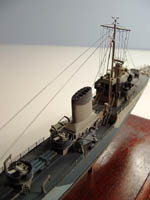 Masking
was adjusted, and WEM Colourcoats sprayed for the decks and disruptive scheme.
Once this was dry further weathering was undertaken, this time of the above
water component of the ship. At bow, stern, and at various points on the hull
a rust mixture was used to depict waterline erosion - this starts at a point
halfway up the boot topping. Rust was also streaked down the hull, both drybrushed
and in small hard dappled streaks, particularly below the hawse pipes and
other major drain points. Darker brown tones depict older rust while lighter
and more orange shades show recent staining.
Masking
was adjusted, and WEM Colourcoats sprayed for the decks and disruptive scheme.
Once this was dry further weathering was undertaken, this time of the above
water component of the ship. At bow, stern, and at various points on the hull
a rust mixture was used to depict waterline erosion - this starts at a point
halfway up the boot topping. Rust was also streaked down the hull, both drybrushed
and in small hard dappled streaks, particularly below the hawse pipes and
other major drain points. Darker brown tones depict older rust while lighter
and more orange shades show recent staining.
Somewhat less rust was used above the main deck, as the crew (even in wartime)
could be expected to be able to reach and maintain these areas. I also used
the very light green/off white shade as the main drybrushing shade to pick
up the hull plating strakes and to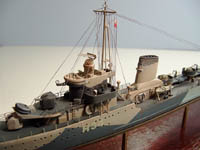 highlight details above deck - this is a handy shade as it makes a very nice
'dried salt spray' as well! Touches of grey, white and brown pastel were used
to show soot around the funnel cowling. Even the props are weathered (and
also stolen from the Italeri Hood - they are better moulded than the kit supplied
versions, if a bit on the small side). They started out as dark bronze green,
and were then drybrushed with gold paint to show a fairly dull colour.
highlight details above deck - this is a handy shade as it makes a very nice
'dried salt spray' as well! Touches of grey, white and brown pastel were used
to show soot around the funnel cowling. Even the props are weathered (and
also stolen from the Italeri Hood - they are better moulded than the kit supplied
versions, if a bit on the small side). They started out as dark bronze green,
and were then drybrushed with gold paint to show a fairly dull colour.
Final touches for the build included the decals supplied with the kit, and
black decal sheet used to depict the wheelhouse windows. 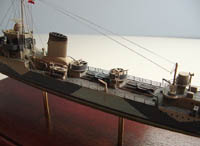 Rigging
is a product called 'Ezi-Line', which I had never tried before. It's meant
to be used for model railway telegraph and power lines. It's a rubbery material,
which stretches into quite thin lines - up to seven times its original length
without snapping according to the blurb enclosed with the reel of material.
It is easily anchored with superglue and works quite well. Care needs to be
taken to use a consistent 'stretch', as it can appear thick if left too slack
- the line is actually a flat ribbon, and this is particularly apparent in
its unstretched state. I'm not sure that I would use it again for an entire
ship's rigging, but it will definitely have applications and it is always
nice to try something new. One advantage this kind of material has is that
you can glue your signal
Rigging
is a product called 'Ezi-Line', which I had never tried before. It's meant
to be used for model railway telegraph and power lines. It's a rubbery material,
which stretches into quite thin lines - up to seven times its original length
without snapping according to the blurb enclosed with the reel of material.
It is easily anchored with superglue and works quite well. Care needs to be
taken to use a consistent 'stretch', as it can appear thick if left too slack
- the line is actually a flat ribbon, and this is particularly apparent in
its unstretched state. I'm not sure that I would use it again for an entire
ship's rigging, but it will definitely have applications and it is always
nice to try something new. One advantage this kind of material has is that
you can glue your signal 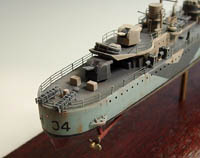 halyards
into their flag bags off the model, instal the bags then stretch the lines
up to the yard arm and glue - this is a very non-messy way of completing what
is often a nerve wrackingly difficult task.
halyards
into their flag bags off the model, instal the bags then stretch the lines
up to the yard arm and glue - this is a very non-messy way of completing what
is often a nerve wrackingly difficult task.
Everything was coated with Floquil flat finish, and Blyskawica was complete.
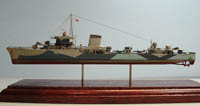 This
is a nice little kit and highly recommended if you want a break from more
complex builds. It has helped to pleasurably fill in the time while I wait
for the photo-etch to finish the bigger ship seen in some of these shots.
I also have the Mirage kit of Wicher, and this is little short of superb,
with some really excellent detail parts, guns, open lattice supports for platforms
and an effective depiction of the hull plate strakes straight out of the box!
I am really, really, looking forward to the Mirage releases of four stack
destroyers promised for this year, as this is a company that improves its
models with every release.
This
is a nice little kit and highly recommended if you want a break from more
complex builds. It has helped to pleasurably fill in the time while I wait
for the photo-etch to finish the bigger ship seen in some of these shots.
I also have the Mirage kit of Wicher, and this is little short of superb,
with some really excellent detail parts, guns, open lattice supports for platforms
and an effective depiction of the hull plate strakes straight out of the box!
I am really, really, looking forward to the Mirage releases of four stack
destroyers promised for this year, as this is a company that improves its
models with every release.